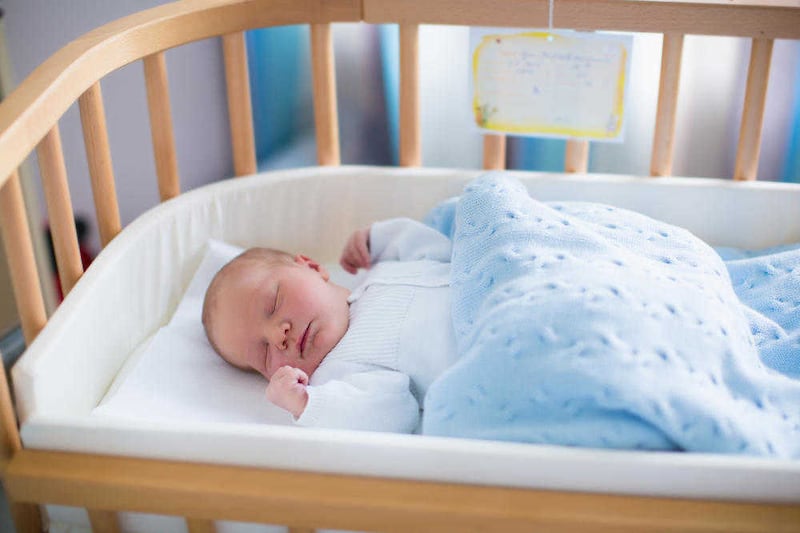BABIES born to young parents have a four times greater risk of dying of unknown causes than babies born to older parents.
That's the shocking statistic revealed by the sudden infant death (Sids) charity The Lullaby Trust, which is using this year's Safer Sleep Week (March 14-20) to get the message across to all parents, and particularly those aged under 20, that the risk of Sids can be reduced massively by following simple safer sleep advice.
Although cases of cot death or SIDS – the sudden and unexplained death of a baby where no cause is found – have reduced dramatically since the 1980s, it still claims the lives of around five babies every week in the UK.
And although over half of new mums with babies under six months of age say their greatest fear is that their baby will die in its sleep, a similar number admit they don't follow safer sleep advice.
The Lullaby Trust wants to bring the number of Sids deaths down to below half the current number by 2020, and as part of that drive, they are launching a new Safer Sleep for Babies animation film that can be shared on smartphones, in a bid to get the message across to younger parents.
Francine Bates, chief executive of The Lullaby Trust, says: "We believe the animation is a very effective way of getting our message across to young people, nearly all of whom use smartphones and are connected to social media."
The film, which will be available on The Lullaby Trust website (lullabytrust.org.uk) from this week and will be shared across social media, focuses on the dos and don'ts of safer sleep, including always lying a baby on its back to sleep, not smoking, and not sleeping in the same bed as a baby if you smoke, drink, take drugs or are extremely tired.
Bates says younger parents' babies are thought to be more at risk of Sids partly because of a lack of awareness, and partly because many young parents are more disadvantaged, with low incomes and little support.
"They're sometimes more vulnerable and dealing with difficult problems in their lives, and often safer sleep isn't at the top of their agenda," she says.
"We want them to understand the basics of safer sleep and how important it is to follow the advice, because clearly there's a risk that a baby may die if they don't do it.
"Babies under the age of one are very vulnerable, and safer sleep is a priority."
While the number of SIDS cases has been decreasing since 1989, the fall was most marked between 1991 and 1992 when the FSIDS (the former name for The Lullaby Trust) Reduce the Risk of Cot Death campaign was launched. While there were 1,173 Sids cases in 1991, the number plummeted to 647 in 1992.
"When cot death was at its height, the vast majority of babies were found to have died on their tummies, so it was clear that putting a baby to sleep on its back was much safer," explains Bates.
"Within five years of telling parents to put babies to sleep on their backs, the cot death rate had reduced by 70 per cent."
Bates points out that while the latest, 2012-2013, figures show a very slight overall increase in Sids deaths, it is thought that the increase may be explained by a very cold spell during 2013 when there was a spike in Sids deaths. This may have been because parents were wrapping babies up more than usual to protect them from the cold, and they were overheating, which is a major Sids risk.
"The fact is, though, that we don't really know because the reason for Sids is still a mystery," Bates admits.
"We still don't know the mechanism for why a baby would stop breathing. That's one of the reasons we continue to raise money for research."
Theories as to the cause of Sids include possible links to changes in a baby's blood pressure and heart rate while lying on their front, or babies being more easily arousable while lying on their back.
Bates adds: "The vast majority of parents follow safer sleep advice – it's embedded now. But it's a continual process – mothers are delivering babies every day, and we constantly have to keep stressing the advice, particularly to younger mums."
:: For more information about safer sleep, visit www.lullabytrust.org.uk/safer-sleep.
SAFER SLEEP TIPS
:: Always place baby on its back to sleep
:: Keep baby smoke-free during pregnancy and after birth
:: Place baby to sleep in a separate cot or Moses basket in the same room as you for the first six months
:: Breastfeed
:: Use a firm, flat, waterproof mattress in good condition
:: Never sleep on a sofa or in an armchair with a baby
:: Don't sleep in the same bed as baby if you smoke, drink, take drugs, are extremely tired, if your baby was born prematurely or was of low birth-weight
:: Avoid letting baby get too hot
:: Don't cover baby's face or head while sleeping or use loose bedding
:: Remove pillows, soft bedding, cot bumpers and soft toys from the cot




